4
Fred Robbins and the Sproull Report
On March 19, 1980, David Hamburg informed the Institute of Medicine Council that Frederick C. Robbins, dean of the Case Western Reserve University School of Medicine, had accepted the offer of the National Academy of Sciences (NAS) to become the IOM's next president. The appointment, he said, had been welcomed "enthusiastically" by all and constituted the "most positive response" that he had ever seen to a change in organizational leadership.1 The leaders of the IOM realized that Robbins would need all the goodwill he could muster. If nothing else, raising funds would be difficult in an economy that was suffering from stagnant employment and sharply rising prices. A week later, Theodore Cooper, head of the IOM Program Committee and former Assistant Secretary for Health in the Ford administration, elaborated on the problems that Robbins would have to solve. Cooper said that the IOM could not let the "somewhat depressing overall economic picture in the country'' lower the level of creativity at the IOM, nor could it let "funding sources control its program" during a period of fiscal constraint.2
As things turned out, Robbins did face many trials. Some of these challenges came from external conditions, such as the state of the economy and the change in administration from Democratic to Republican. Others stemmed from internal conditions, such as the change of administration at the National Academy of Sciences. The Robbins era culminated at the end of 1984 with a report from an NAS committee that seriously questioned whether the IOM should continue to exist as an entity of working members who engaged questions of social importance. The report implied that the IOM designed by Walsh McDermott should come to an end and a new National Academy of Medicine should take its place. Ultimately, Robbins managed both to expand upon the work of David Hamburg and to reaffirm the concept of the IOM. Child health became an important area of concern for the IOM during the Robbins years; so did studies related to vaccine supply and medical technology. Still, there were always distractions. Just as organizational questions had
preoccupied the Board on Medicine, so structural matters consumed the time of Fred Robbins. Although the IOM survived the challenges that arose between 1980 and 1985, the ordeal sapped some of the organization's energy that could otherwise have gone into its expansion.
Searching for Frederick Robbins
In picking David Hamburg's successor, the IOM knew it had a reasonable amount of lead time. Hamburg announced his resignation at the beginning of 1979, and a new IOM president would not have to be in place until the fall of 1980. In March 1979, the IOM created a search committee, composed of members of the Executive Committee, two other members of the IOM Council, and one former Council member. This group selected William Danforth, the chancellor of Washington University in St. Louis, to be its chairman. At its first meeting, the search committee elaborated on the desirable qualities for an IOM president. Some of the characteristics, such as "leadership ability" or a "knack for institution building," were self-evident, but others revealed a great deal about the culture of the IOM. Membership in the National Academy of Sciences was "desirable but not essential"; an M.D. degree was "preferable but not decisive." The committee noted that a ''research scientist" might be acceptable if he or she had ''good rapport with" and "recognized stature in" the health professional community, implying that it was unlikely the search committee would select, for example, an economist. The IOM was about medicine and would, in all likelihood, be lead by a medical doctor, preferably one who knew something about health policy, who had gained an international perspective on the issues, and who had an "appreciation of the need for constant attention to fund-raising."3
The search committee looked for help from two individuals. One was Walsh McDermott, who had been active in all of the previous searches and was the resident expert on the IOM's original mission. The other was Julius Richmond, who had chaired the previous search, which was widely regarded as a great success, and who was in touch with the latest developments in health policy through his government post as Assistant Secretary of Health. The committee's choice of advisers reflected its desire to keep the selection process within the IOM family and not to broaden the search much beyond the IOM and the world of academic medicine. The committee decided, for example, not to advertise the position in a widely circulated publication such as the New York Times. Instead of putting an ad in a newspaper or
journal, William Danforth solicited nominations from medical school deans, the presidents of 50 colleges, and IOM members.4
Despite the closely held nature of the process, the search yielded more than 140 nominations. The search committee interviewed eight candidates and submitted a final list of four to the IOM Council. By the end of 1979, the search committee and the Council had put Frederick Robbins at the top of the list. "Fred Robbins is clearly our first choice," William Danforth told NAS President Philip Handler, "we recommend that all efforts be made to secure his services."5
Robbins's career path resembled that of other IOM presidents. After receiving his undergraduate degree at the University of Missouri, he went first to the University of Missouri Medical School and then to Harvard, where he completed his M.D. During the war, Robbins did important laboratory work for the army, identifying the agent that caused a certain form of pneumonia. After the war, Robbins returned to Harvard and continued his work as a pediatrician with a strong research interest in infectious diseases, joining John F. Enders' laboratory and participating in the studies of viruses that caused mumps and polio. The work that Enders, Thomas Weller (who was a charter member of the Institute of Medicine), and Robbins did in cultivating the polio virus earned them the Nobel Prize in medicine in 1954. By this time, Robbins had already left Harvard to become director of pediatrics and contagious diseases at Cleveland's City Hospital and professor of pediatrics at Case Western Reserve University. News of Robbins's Nobel Prize caused quite a stir in Cleveland, although Robbins's wife Alice claimed to be unimpressed, because her father, as it turned out, had also won a Nobel Prize.6
Robbins spent the bulk of his career at Case Western. In 1966, he became dean of the Medical School and succeeded in making this school one of the most exciting places to study medicine in the nation. As dean, Robbins fostered the creation of new departments of Community Health and Family Medicine, and he made sure that students received a solid grounding in primary care. Presiding over turbulent times in a calm and unflappable manner, he was, according to his Case Western colleagues, a capable leader, willing to compromise, rather than a firebrand or an innovator. "I'm not going to revolutionize things," he told a reporter at the time of his appointment as IOM president. He sought at first simply to continue the program that David Hamburg had begun.7
Robbins was already an IOM insider. Like David Hamburg and Donald Fredrickson at the time of their selection as IOM president, he had served on the IOM Council. Unlike these two, Robbins had
also been in residence at the IOM as a senior scholar. Taking a sabbatical during 1977–1978, he came to the IOM and chaired the steering committee for the studies of saccharin and food safety policy. As a member of the IOM's Executive Committee, Robbins might be thought of as part of the Hamburg administration, in a manner analogous to a federal cabinet officer. With perfect justification, Hamburg could tell the members of the IOM that "Fred has been deeply committed to the tasks of the Institute." His accomplishments as physician, scientist, educator, administrator, and government adviser matched "the breadth of the Institute's mission."8
Robbins was accomplished, in a sense that set him apart from those who had already served as IOM presidents. At the time of his appointment, Robbins was 63, only three years away from being designated a senior member. He had already been a dean, already become a member of the National Academy of Sciences, and already won the Nobel Prize. Walsh McDermott hoped that the IOM would be led by young and vigorous men and that its ranks would constantly be replenished by younger men. Hogness, Fredrickson, and Hamburg were all young men on the rise, and each went on to greater prominence after having served as IOM president. Hogness became a university president; Fredrickson served as head of the National Institutes of Health (NIH) and head of a foundation; Hamburg took a job at Harvard and then became the head of the Carnegie Corporation. It was unlikely that Robbins, who would be 68 at the end of his term, would follow a similar path. Unlike the personable and energetic Hogness, the intensely intellectual Fredrickson, or the charismatic Hamburg, Fred Robbins, an affable and highly competent man, would maintain what others had created. From the very beginning, he faced an uphill fight. The first thing that NAS President Philip Handler told him was that Handler should never have allowed the IOM to get started.
The 1980 annual meeting, held in the middle of October, marked the formal beginning of the Robbins era. The program that year featured a look at health in the new decade and included speeches by Robert Wood Johnson Foundation head David Rogers, Nobel laureate geneticist Joshua Lederberg, future Nobel laureate economist Kenneth Arrow, and distinguished jurist David Bazelon. Much of the program was celebratory in nature. On the first day, the Institute held a special symposium in honor of David Hamburg in which five distinguished scientists gave papers on "Adaption, Stress, and Coping." The inauguration of Frederick Robbins came on the second day. The audience heard a message from John Enders who reminisced
about Robbins's days at Harvard and a speech by Philip Handler on Robbins's scientific and medical contributions.9
Backlist of Projects
As Robbins settled in as head of the IOM, he administered a series of projects that began in the Hamburg era and came to a conclusion during his presidency. The situation resembled that of the new head of a Hollywood studio, who had first to market his predecessor's films before he could promote his own. Robbins found a backlist of at least five projects that, in a manner typical of the Institute of Medicine, covered a wide range of subjects.
Some, such as the airline pilot study, were narrow in focus yet of vital interest to the groups involved. The study stemmed from a controversy that had arisen over a Federal Aviation Administration (FAA) rule prohibiting commercial aviation carriers from allowing anyone over 60 to pilot or copilot a plane. As the generation of pilots trained in World War II and Korea aged, they began to feel that the FAA rule was discriminatory and unnecessary. They formed groups such as the Pilots' Rights Association and petitioned Congress to pressure the FAA to change the rule. Congress responded, as it did in many controversial situations, by calling for a study of the matter.10 At the beginning of 1980, Donald Fredrickson, the head of NIH, contacted David Hamburg about having the IOM do the congressionally mandated study. Although the IOM Council reacted with enthusiasm, it took many months for federal officials to decide if they wanted to enter into a contract with the IOM or whether they preferred to do the study in-house. Not until June was a contract signed and a study group appointed. The IOM panel would confine itself to objective medical findings on the subject of pilot performance and age, and the National Institute of Aging would use the data as part of its formal response to Congress. 11
The IOM decided to form a series of task forces to examine the effects of aging on various bodily systems, for example, one that focused on the cardiovascular system. The group made site visits to places such as the American Airlines Flight Academy in Dallas, Texas, where it hoped to acquire a sense of the physical skills involved in flying a plane. The final report, a product of the IOM's Division of Health Sciences Policy and a steering committee headed by Robert F. Murray, chief of the Division of Medical Genetics at Howard, appeared in 1981, about five months after Fred Robbins's inauguration.
The report was decidedly tentative in tone. On the one hand, the group noted that for significant acute events, such as a heart attack or stroke, age 60 did not mark the beginning of a period of special risk. On the other hand, the group concluded that "subtle changes that may adversely affect pilot performance" increased with age. A pilot's skills deteriorated with age, yet there was great variation among individuals in any particular age group. The committee implied that tests of individual acuity should be developed that could take the place of a blanket exclusionary rule. In the end then, the report called, as did nearly every IOM report, for further research that would make such tests possible.12
Another study on the backlist concerned nursing education and marked a throwback to the large data-gathering studies that had been done by Ruth Hanft. Just as the IOM was asked to investigate how the federal government should subsidize medical education at the beginning of the 1970s, so it received a similar request to investigate nursing education at the end of the decade. In the Nurse Training Amendments, passed in 1979, Congress sought the IOM's help in resolving a controversy over whether there should be continued federal support of nursing education. Although the study would not involve the data-gathering efforts that had marked the earlier study supervised by Hanft, it was nonetheless a large and ambitious undertaking that was scheduled to take two years to complete.13
The Institute of Medicine asked Arthur Hess to head the steering committee that included some truly distinguished practitioners in the field of health services research. Hess was a veteran bureaucrat from the Social Security Administration who had helped launch the Medicare program. Other members included Otis Bowen, a medical doctor from Indiana who later became governor of Indiana and Secretary of Health and Human Services; Stuart Altman, dean of the Heller School of Social Welfare at Brandeis; Saul Farber, head of the Department of Medicine at New York University; John Thompson, a professor of nursing education at Yale; Isabel Sawhill, a specialist in manpower policy at the Urban Institute; and Linda Aiken, a nurse with a Ph.D. in sociology who worked for the Robert Wood Johnson Foundation. This panel plunged into the complexities of federal subsidies for nursing education.
The tone of the 1983 report, a product of the IOM's Division of Health Care Services, revealed some of the differences that had occurred over the course of a decade in the field of social policy. The nursing report, unlike the IOM's earlier report on federal support for medical education, did not reflexively call for more federal spending or regulation. On the contrary, the group concluded that "no specific
federal support is needed to increase the overall supply of registered nurses, because estimates indicate that the aggregate supply and demand for generalist nurses will be in reasonable balance during this decade." Despite this finding, the study group had no intention of abandoning the IOM's earlier efforts at social reform, arguing, for example, that states and private employers should facilitate the actions of nurses who wished to upgrade their skills, particularly those nurses who wished to pursue clinical, rather than administrative, careers. In a similar vein, the group believed that the federal government should cosponsor, with states and private foundations, demonstration projects designed to alleviate nursing shortages in medically underserved areas and that the federal government should institute a "competitive" program to provide scholarships for members of minority and ethnic groups who wanted to be educated as nurses. Nurse practitioners also received the study group's endorsement, as in the recommendation that the federal government should continue to support the training of nurse practitioners who were needed in medically underserved areas and in programs caring for the elderly. Words such as "competitive" and public-private or federal-state "partnerships'' reflected the new conservative tone of the era. One could no longer simply assume that health professions education was a public good deserving of federal support or that an increase in the number of health care practitioners was socially desirable. At the same time, the report made it clear that the study group and, one might infer, the Institute of Medicine believed in a strong federal presence in the field of health manpower.14
The government's proper role in maintaining an adequate supply of doctors also figured in a study the IOM carried out for the Department of Defense on graduate medical education in the military. A doctors' draft, meant to handle the contingencies of the Vietnam War, ended in June 1973. Without a ready supply of doctors, who were needed to provide care to servicemen stationed around the world and to be prepared for the onset of another war, all three branches of the military faced a crisis. One way around this problem was to pay for a person's medical education in return for a period of military service. Another way was to allow a medical doctor to take his or her internship and residency while on active duty. By the late 1970s, a substantial number of active-duty military physicians were interns, residents, or fellows, and the Department of Defense ordered the services to limit the fraction of military physicians in graduate medical education to not more than 20 percent of their authorized physician strength. All three of the uniformed services protested this
ruling. So the Assistant Secretary of Defense for Medical Affairs asked the IOM to undertake a study of graduate education in the military services.15
The IOM complied. Using its remarkable ability to assemble experts in a given area of medical policy, the IOM put together a strong steering committee. Leonard Cronkhite, who was both president of the Medical College of Wisconsin and a major general in the U.S. Army Reserves, agreed to chair. The group decided that the policy question of how large the Uniformed Services University of the Health Sciences, which was essentially a military medical school, should be could not be "answered objectively and unambiguously." Nonetheless, the group recommended that the Department of Defense withdraw its directive to limit the percentage of military physicians in graduate medical education assignments to 20 percent. Instead, each military medical department should be permitted to adjust its graduate medical education programs "to meet the changing manpower circumstances and requirements that it faces." In order to do this, the Department of Defense should produce a set of "planning guidelines, programs, and personnel policies" for each of the services.16 In this manner, the report, done quickly and with rather cursory analysis, contained a variant on the usual ''more research is needed" recommendation. It also showed just how reluctant the members of the IOM steering committee were to part with an important federal subsidy to medical education. For many influential IOM members, including every one of its presidents, military service had been an important part of their medical and research training. Of course, they had had little choice about the matter, and their service sometimes stretched into a long period that interfered with their careers. These doctors wanted future generations of physicians to enjoy the opportunities that military service provided, without being disadvantaged in comparison to their civilian peers.
Differences in generational outlook also figured in another of the IOM studies that Fred Robbins inherited from David Hamburg. This study, on the health-related effects on marijuana use, reflected the IOM's role as an arbiter of public health. The National Institutes of Health initiated the request for the study, perhaps because federal officials understood just how controversial a topic marijuana use was and wished to have it investigated by an external authority.17 For the IOM, the study resembled the one it had done on the health effects of legalizing abortion. Although in both cases the subject was controversial, the IOM restricted its investigations to the health aspects, not the morality, of the subject under investigation. In both cases, the IOM discovered that the subject was so emotional that it
was difficult to conduct a dispassionate inquiry. In both cases, the IOM faced a dissonance between the ambiguity of the data and the almost religious certainty of people on opposing sides of the issue.
The study fell into the domain of the Health Sciences Division at the IOM. Enriqueta Bond, a talented scientist who would become an increasingly important part of the IOM's history, did much of the staff work for the project. She had arrived at the Academy complex as a study director in the Division of Medical Sciences of the National Research Council (NRC). IOM staff member Elena Nightingale recruited her to come over to the IOM and work on studies related to genetic screening in the workplace. According to Bond's later recollection, "the IOM was the new kid on the block doing innovative things and having substantial impact in the policy world."
On the marijuana study, Arnold Relman, editor of the New England Journal of Medicine, played a prominent role as chairman of a large steering committee that was divided into many subpanels that examined such aspects of the problem as reproductive and fetal issues and behavioral and psychosocial issues. When Relman met with the group for the first time on April 15, 1981, he told members that their task was to write a report that could "be used a guide to policy but which itself is not required to suggest policy—thank God." He noted that the group operated in "the context of a very polarized social and political scene" and that its work would be "watched and prodded and ... criticized by many contending forces.'' He suggested that the members be "totally indifferent to these social and political forces and just do our jobs as scientists and physicians and evaluators, dispassionate evaluators of the evidence."18
Even as Relman spoke, the IOM began to receive scores of letters from grassroots proponents and opponents of marijuana use. For example, Robert L. Mitzenheim urged that marijuana be used by people with glaucoma or undergoing chemotherapy. "After seeing people go through these things without even the chance to try the THC [an abbreviation of the chemical name for the active ingredient in marijuana], my feelings have become stronger in opening new doors for them; I personally would use it, law or no law," he wrote. Thomas E. Campbell reported that he smoked marijuana three or four evenings a week and found that it relaxed him and enabled him to sleep. With regular marijuana use, Campbell said, he could reduce his alcohol consumption below his previous level of six drinks per day and his use of tobacco from his previous pack-a-day habit. The steering committee also received mail from a Martha Stone, who offered testimony of how her child's marijuana use produced four years of "absolute chaos in our home." A writer from Celeste, Texas, told the
lamentable tale of her nephew Rick who was sitting in jail awaiting trial. When he was in elementary school, he was the ideal child, "smart, handsome, active, enjoyable." Then he discovered girls and marijuana, and paradise was lost. After that, "instead of bringing home those straight A report cards, he brought home misery."19
The IOM ignored these letters and probed the facts. Relman pressed steering committee members who brought him anecdotes on the detrimental effects of marijuana to bring him the facts. When one member told him that marijuana could produce an "acute brain syndrome," Relman asked if the phenomenon was well documented in the literature. Told that it was not, Relman replied, "We have to be very careful. We cannot cite our own clinical experience in this."20 The reality was, however, that facts could take the group only so far. As a steering committee member pointed out, "the ultimate decision about the question may be nonscientific, maybe more a political, social, cultural, moral kind of thing." One member went so far as to suggest that the IOM get some "young people to read some of the report and see if it has verisimilitude.''21
The final report, which came out at the end of 1981, took a very cautious approach to the subject. It pointed out, for example, that smoking marijuana produced "acute changes in the heart and circulation that are characteristic of stress" but concluded there was no evidence "to indicate a permanently deleterious effect on the normal cardiovascular system occurs." Marijuana produced acute effects on the brain, but there was simply not enough evidence to determine "whether prolonged use of marijuana causes permanent changes in the nervous system or sustained impairment of brain function and behavior in human beings." Although marijuana might possibly be useful in the treatment of glaucoma, the control of nausea and vomiting, and the treatment of asthma, the group could not say this for sure and thought that other, already approved therapeutic agents made more biological sense than THC. The antidote to all of this ambiguity was more research—the IOM's universal antidote. "The explanation for all these unanswered questions is insufficient research," the report noted.22
For all of its caution, the report could be read as an indictment of marijuana use. "Our major conclusion," the steering committee wrote, "is that what little we know for certain about the effects of marijuana on human health—and all that we have reason to suspect—justify serious national concern."23 The committee worried particularly about the effects of marijuana on child development. In these ways, the marijuana study resembled the abortion study. In both cases, the fundamental beliefs of the steering committee were clear: in the one
instance, prochoice, and in the other, antimarijuana. Both reports left the impression that further research would buttress these basic beliefs.
Not everything that the IOM studied in the areas of public health and health sciences concerned subjects of long-standing duration. Just as Fred Robbins took over from David Hamburg, the IOM became involved in the emerging concern over toxic shock syndrome. This term first came into currency in 1978 and drew a large amount of attention in the spring and summer of 1980. At that time, epidemiologists discovered a link between cases of toxic shock, which could produce dangerous fevers and even death, and young women's use of tampons. A particular brand of tampon, known as Rely and manufactured by Procter and Gamble, appeared to produce a disproportionate number of cases. In response, Procter and Gamble withdrew Rely from the market in September 1980. A few weeks later, Johnson and Johnson, also a manufacturer of tampons, approached the IOM about doing a study of toxic shock syndrome. Very aware of the need to protect the IOM's reputation for objectivity, Fred Robbins told Johnson and Johnson that the IOM would like to do the study but would require a broader base of funding. In the end, four government agencies, Johnson and Johnson, and Procter and Gamble all helped to finance the project. It proved to be an interesting collaboration between the IOM and private industry. When the steering committee met for a second time on September 21, 1981, for example, it heard from both of the manufacturers under an elaborate set of guidelines. The representatives of one company agreed to leave the room when representatives of the other spoke, in an effort to protect proprietary information.24
The report on toxic shock syndrome was highly technical in tone. The steering committee, chaired by Sheldon Wolff, head of the Department of Medicine at Tufts and physician-in-chief of the New England Medical Center, noted that cases of toxic shock were rare but severe. It therefore seemed prudent to give women enough information to allow them to make informed decisions about tampon use. At the same time, the committee felt that the available information indicated that women who had had toxic shock syndrome, who were postpartum, or both should not use tampons. Women between 15 and 24 years of age who used tampons needed to understand that they were at higher risk than older women, and all women should minimize their use of high-absorbency tampons of the Rely type.25
The toxic shock syndrome project showed that the disease environment changed with time. The very conditions of modern life
produced new health complications. In this particular case, the public needed an organization it could trust to judge the safety of a product used by a high percentage of women. The IOM, with its ability to assemble experts relatively quickly and its complete independence from large companies such as Johnson and Johnson, met this need.
The Ebert Report
Circumstances forced Fred Robbins to spend a great deal of time removed from the sorts of scientific considerations that informed the marijuana and toxic shock studies and to be engaged instead in practical matters of governance. A case in point concerns the rules for membership in the IOM. When Robbins took over at the end of 1980, the organization faced a major decision. The initial group of members, selected by Robert J. Glaser and members of the Board on Medicine, joined the organization in 1971. The rules allowed them to serve two five-year terms before they became senior members. Senior members could take full part in the IOM's activities with two significant exceptions. They could neither vote in the final membership elections nor serve on the IOM Council. As many as 76 members would complete their 10 years of active service at the end of 1981. As the date approached, the IOM Council began to reconsider whether it wanted to risk losing the services of so many of its experienced members.26
The answer was no. Instead of following the Walsh McDermott dictum that the IOM always be in the hands of young and energetic members, the IOM chose to make membership almost a lifetime condition. On September 16, 1981, the IOM Council voted to abolish the two-term limit. A man who was elected at age 45, for example, could continue as an active member until he reached age 66, at which time he became a senior member. Before this age, he would receive a letter from the IOM president every five years, asking if he wished to continue in active membership or become a senior member. If he wished to continue, all he had to do was say so. At the same time the IOM Council made this decision, it also decided to raise the ceiling on total membership in an effort to leave room for new members. Before 1981, the number of active members was capped at 400. The Council wanted to abandon the ceiling altogether; IOM members preferred some sort of limit. The compromise was to raise the maximum number of active IOM members to 500 in 1981. In agreeing to these changes, Robbins recognized the risk that the IOM could be dominated by "relatively older members"—in other words, people like
himself. He pointed out, however, that because the average age of election to the IOM was 53, the abolition of terms added only three years to an average active member's term.27
At the same time the IOM decided, in effect, to conserve its membership, it also took steps to protect its basic structure. At the end of David Hamburg's term, he appointed a task force to examine the IOM's structure and its relationship to the rest of the National Academy of Sciences. William Danforth agreed to chair the group. Even though the task force originated with Hamburg, Fred Robbins essentially took it over, and it became his vehicle for shaping the organization to his liking. When the task force met in the spring of 1981, it examined such questions as the distinctions between active and senior members and the relationship between the IOM and the Assembly of Life Sciences (ALS) in the National Research Council. Robbins decided that the effort should culminate in a special retreat that summer at which the IOM Council could take stock of the organization's progress. 28
The need for such a review was made more urgent by the fact that the National Academy of Sciences also had a new president. Frank Press, a distinguished physical scientist from the Massachusetts Institute of Technology (MIT), who had served as President Carter's science adviser, took command of the NAS in 1981. He put his vice president, James Ebert, an embryologist from the Carnegie Institution, in charge of reviewing the relationships among the various NAS units. Both Press and Ebert agreed to meet with the IOM Council at the July retreat.29
The interim report of the IOM task force on structure formed the basic text for the July retreat. It could be thought of as an affirming document because it validated the IOM's philosophical underpinnings. The report stated that there was no need for a fundamental change in the IOM's organizational structure and that the IOM should continue to examine issues "with intertwined policy and scientific components." Indeed, "a central element in the whole concept of the IOM was the blending of these two domains of study." In order to accomplish this blend, the IOM should seek flexible funds that would give it more freedom to undertake studies at its own discretion. It should also work with the National Research Council to streamline the cumbersome report review process and to eliminate the overlap between the IOM's activities and those of the Assembly of Life Sciences in the NRC. In particular, the report recommended that the NAS consider removing the Division of Medical Sciences (which was part of the ALS) from the NRC and putting it in the IOM. Short of this, the IOM president might serve as the chairman of the Division of
Medical Sciences. The IOM president, burdened with so many responsibilities, should also be allowed to name a vice president to lighten his load. 30
The IOM Council members agreed with the task force that the IOM should remain true to its original design and mission. As a corollary, the Council advised the IOM to create a resources development committee to develop a plan for raising "an adequate pool of independent, flexible funds" that would meet the Institute's long-range financial needs. The option of appointing a vice president "should remain open." More urgently, the IOM should persuade Frank Press to revise the NAS report review system and should point out to him "as forcefully as possible'' the detrimental effects of maintaining so many redundant units within the Academy.31
In the fall of 1981, Fred Robbins wrote Frank Press that there was a "significant and disturbing problem of overlap in the program interests of the IOM and the ALS." The program plan, style of operation, and "general scope" of the Division of Medical Sciences "increasingly converge" with the IOM, leading to "friction, 'turf' sensitivities, and confusion" in the minds of funders. After 10 years of existence, the IOM had proved its worth to the NAS, and it ''would be unfortunate to compromise the IOM's value by allowing ... a diminution of its vitality through organizational overlap." The solution was to merge the Division of Medical Sciences into the IOM.32
The Ebert report on the organization of the National Research Council appeared in February 1982. It proposed that the NRC be divided into six major units, including one devoted to human health and medicine that would encompass some of the functions of the Assembly of Life Sciences and of the IOM. The unit would be "housed within the Institute of Medicine and overseen by the IOM Council" and would end the overlap between the ALS and the IOM. In other words, the Ebert report suggested that the IOM be given much of what it wanted.33
The IOM greeted the Ebert report with enthusiasm. In March, the Council approved the concept of merging IOM and ALS activities and agreed that it should become the governing body of the new commission. As part of its new responsibilities, the Council decided that it should contain more members from the biomedical sciences.34
In the end, little substantive change occurred. The National Research Council did get a substantial facelift in the spring of 1982 with the creation of new commissions and boards. What were assemblies in the old organizational scheme became commissions in the new one. Hence, the old Assembly of Life Sciences became the new Commission on Life Sciences. Still, the NAS Council hesitated to
confer greater power on the Institute of Medicine, and as a result, the merger of the Division of Medical Sciences and the IOM never took place. Although the Division of Medical Sciences was abolished, the NAS failed to authorize a Commission on Human Health and Medicine. Instead, Fred Robbins, the president of the IOM, became chairman of the Commission of Life Sciences in the summer of 1982.35
The resolution of organizational issues, however unsatisfactory, freed the IOM to concentrate on other pressing concerns, such as the criteria for membership and the creation of a realistic program plan. In July 1983, Robbins appointed a special task force, headed by John Hogness, to investigate the membership selection process. Hogness's task force sought to counter the "general perception that although the general level of quality remains high, the quality of some candidates nominated for and elected to membership has been marginal." The solution, the group decided, was to incorporate "a minimum threshold of accomplishment" into the process. Robbins also tried to tighten the process by which the organization planned its activities, although this proved to be an arduous task. In 1981, for example, Irving London, chairman of the advisory committee to the IOM's Division of Health Sciences Policy, reported with some exasperation that attendance at meetings was spotty, enabling a few people to dominate the proceedings. The division did not set its own priorities as much as respond to often highly specific requests from government agencies, with the result that broader studies tended to be neglected. London concluded that the division needed independent funding so as not to be dependent on federal agencies.36
Advent of the Reagan Administration
The arrival of the Reagan administration made the need for financial and intellectual independence seem all the more urgent. Even at the end of the Carter administration, the IOM experienced considerable difficulties securing contracts from the federal government. The change in administrations exacerbated the problems, as efforts to work with such agencies as the Health Care Financing Administration indicated.
The Health Care Financing Administration (HCFA), whose purpose was to unite the administration of the Medicare and Medicaid programs, was a creation of Joseph Califano and the Carter administration. It appeared logical that the IOM would work with HCFA as it pursued questions related to the reimbursement of hospitals and physicians and as it handled issues of quality of care.
The IOM sought a cooperative agreement—a mechanism somewhere between a grant and a contract—with HCFA that would assure the agency of ready IOM advice on these matters. It helped that Robert Derzon, the first head of HCFA, had a close relationship with the IOM and later became an IOM visiting fellow. When Leonard Schaeffer, who was Derzon's successor, met with the IOM Council on May 9, 1979, he expressed a strong interest in working with the IOM on physician reimbursement issues. On Schaeffer's last day in office, he signed a cooperative agreement with the IOM, yet nothing came of it. At the end of December 1980, for example, the IOM sent HCFA a proposal for a workshop on physician reimbursement policies under Medicare and Medicaid, but it was clear that HCFA was wary of the proposal. At most, the agency wanted only a forum for physicians "to ventilate their concerns," and it did not wish the IOM to make specific recommendations on changes in physician reimbursement. HCFA officials, it became evident, had no desire to tie the hands of the Reagan administration before it had even begun.37
The IOM never did find its niche in the area of hospital and physician reimbursement under Medicare. In 1983, Congress approved a prospective payment system for hospitals that depended on a statistical mechanism known as a "diagnosis-related group." Although the IOM had once made a similar proposal, it played no role in the development of the one that was adopted. After the 1983 legislation, IOM members continued to cite physician reimbursement as a priority and developed an elaborate proposal to evaluate alternative methods of paying physicians. Despite the self-described "intense interest" of IOM members in this subject, HCFA rejected the IOM proposal and awarded instead a contract to a group of Harvard researchers to study what were known as "resource-based relative value scales." These scales provided a means of comparing the services of doctors in different medical specialties—for example, a surgeon and a general practitioner—and served as a basis for changes in physician reimbursement under the Medicare program that Congress made in 1989. Once again, the IOM played no role in the research that led to the change.38
Not all of the IOM's overtures to the government were rejected in the Reagan era. The organization achieved notable success in forming cooperative agreements with the Public Health Service (PHS). The parties signed the first such agreement in February 1981. With the funds received, the IOM transformed three of its divisional advisory committees into boards that could conduct independent investigations. The new Board on Health Promotion and Disease Prevention, for example, took the place of the old advisory committee for this IOM
division. Support from the PHS was neither certain nor steady, yet it persisted throughout the Reagan administration. In 1982, the Public Health Service could provide only 60 percent of the amount it had given the year before. Federal officials, such as Edward Brandt, the Assistant Secretary for Health, indicated that they would try to increase the amount in the following year. In 1983, the Public Health Service came through with more money, extended the agreement for another year, and made plans to support a fourth division board. 39
Despite this cordial gesture from the Public Health Service, the fact was that the Reagan administration had a chilling effect on the IOM's development and on the entire National Academy of Sciences complex. In January 1981, for example, the IOM learned that a study of federal research policies that was considered promising would not be funded by the Department of Health and Human Services (HHS) because Richard Schweicker, the new HHS Secretary, had other priorities. The Democratic Congress that left town in 1980 had wanted the IOM to review the state of the art in neurological research. The mixed Congress—Democratic House and Republican Senate—that came to town in 1981 refused to appropriate money for the study. Senator Edward Kennedy (D-Mass.) wanted the IOM to form a Council on Health Services Research, but IOM leaders knew that legislation mandating such a council would never be passed. Robbins believed that without such a mandate, further discussion would be "fruitless." Even with a legislative mandate, it was often difficult to undertake a study. The Omnibus Budget Reconciliation Act of 1981 contained a provision for the IOM to study the implications of the increasing number of physicians. With the administration less than enthusiastic, the study was never funded.40
The hostility of the Reagan administration hit the entire NAS hard, particularly after President Carter's science adviser made the transition to the Academy. Many parts of the NRC received fewer contracts to undertake studies, just when the NAS had leased a new building, known as the Joseph Henry Building, from George Washington University. The administration also attempted to make deep cuts in the budgets for the National Institutes of Health, the National Science Foundation, and the other parts of the government that supported scientific and statistical research. This prompted serious concern at the Academy, which sponsored a conference in October 1981 to consider the impact of the administration's prospective budget cuts, and at the IOM, where Council members noted that budget cuts would affect "the entire NIH enterprise" and academic health centers as well. As for support for health services research, it was practically "defunct," according to Johns Hopkins
professor of pediatrics and health services research and IOM Council member Barbara Starfield.41
This sort of discussion underscored the fact that the IOM, despite its record of serving both Democratic and Republican administrations, often found itself in opposition to the Reagan administration. Officials in the Reagan administration, for their part, often interpreted the IOM's actions as hostile. For example, the IOM offered a number of Democratic officials a setting in which to make the transition from government to other types of work. In this manner, Howard Newman, a former director of HCFA, became an IOM member in residence during 1981. For the IOM, the offer to Newman was similar to the one it had made to Theodore Cooper at the end of the Ford administration and indicated no disapproval of the Reagan administration. To the administration, however, which was intent on making revolutionary changes in the relationship between the government and its citizens, harboring former Democratic officeholders was a suspicious act. At times too, the IOM's advocacy of an agenda that it had built up over the course of a decade created the possibility of conflict with the Reagan administration, as in the desire of some IOM members to issue a statement decrying the lack of access to health care for those unable to pay. The IOM Council squelched this initiative, saying it did not wish to issue a "moral statement" that was not supported by data. The Council did encourage the IOM to do a formal study of ways to facilitate access to health services for those unable to pay for them. Although such a study represented an important priority of the IOM's Program Committee, the NRC governing board rejected it for fear that it "implied subtle criticism of the current administration." Robbins replied that the "Institute strives to be unbiased about political issues." Still, ''occasions may arise when it must make recommendations that are contrary to current administration policy." Whatever the imperatives of the moment, the study was never done. A study of the medical consequences of nuclear attack on the United States languished for similar reasons.42
Studies During the Reagan Era
Many of the studies that the IOM launched during the Robbins's presidency reflected the influence of the changed ideological climate induced by the Reagan administration. Where before the Institute had studied "health care in a context of civil rights," it now turned to the growth of "for-profit investment in health care." First suggested in 1981, the study was not begun until 1983, when the IOM secured
partial funding through the Andrew Mellon and John A. Hartford foundations and through a number of private companies in the hospital management business. As always, however, the IOM took pains to ensure that there was no impropriety in the funding arrangements, working hard to guarantee that the private companies had nothing to do with picking the members of the steering committee or conducting the study. To set the tone, the IOM hoped to interest a "distinguished citizen with no vested interest" in chairing the study committee. After John Dunlop, the Harvard professor and former Secretary of Labor who had briefly served on the Board on Medicine, and Kingman Brewster, the former president of Yale, declined, the IOM settled on Walter McNerney of the Blue Cross Association.43
Despite the many financial contributors, the project was run on a shoestring, with the constant need to seek additional funding. At one point, for example, Brad Gray, the project staff director, decided to abandon commissioning two papers on ethical issues for want of money. Roger Bulger, president of the University of Texas Health Science Center at Houston and former IOM staffer, came to Gray's rescue by agreeing to have his institution fund the papers.44
The bulk of the committee meetings took place in 1984, during the period in which Ronald Reagan thrashed Walter Mondale in the general election. Discussions revealed the polarized opinions that people brought to the table. Kenneth Platt wondered if profits in health care were "obscene," because they led to discrimination against the poor and produced negative influences on physician behavior. John Bedrosian pointed to the many positive features of the investor-owned segment of the health care industry, such as the creation of new facilities, the development of services, and the investment of millions in underserved communities. Paul Ellwood, the noted authority on health maintenance organizations, predicted that in 10 years there would be only 10 large suppliers of health care, because of the large advantages for-profits enjoyed in access to capital. Clark Havighurst, an expert on health policy and the law, reminded the committee of all the changes that had taken place in the field: competition had become mandatory; advertising was permitted; boycotts were prohibited; and restrictions had been relaxed against the corporate practice of medicine. Above all else, decisionmaking power had shifted from physicians to the purchasers of health care, who wanted to reduce costs through such devices as prospective payment. Such changes were bound to have an effect on the quality of care. Havighurst pointed, in particular, to the problem of access for the "near-poor." He argued that the problems should not be corrected by "reregulating the industry." It was better, Havighurst argued, to
give the near-poor increased health purchasing power, perhaps in the form of vouchers.45
The discussions held by the steering committee on nonprofit enterprise in health care went to the very heart of the changes taking place in the Reagan era. In the end the group debated whether to focus the report on these changes as, in Walter McNerney's words, a "natural outgrowth of public disillusionment with a regulatory perspective and the inefficiency of nonprofits." In this view, the committee should publicize the way in which investor-owned enterprises "seized the opportunity created by cost-based reimbursement, deregulation, and a maturing market." Others argued that merely to describe the historical process missed its meaning. In this view, the report should emphasize how the growth of for-profit health care undermined the role of the physician as an agent for the patient and how the growth of entrepreneurial activities had a deleterious effect on the "fiduciary" relationship between doctor and patient.46
The final report reflected a compromise between the two views. It both described the changes that were taking place in the health care industry and tried to assess some of their consequences. The committee concluded that there was no evidence to indicate that investor-owned hospitals were less costly or more efficient than not-for-profit organizations. At the same time, these types of companies did make "services more readily available" to the people they served. Still, there was enough evidence to suggest that the for-profits provided very limited amounts of uncompensated care, which only served to increase the burdens on the nonprofits. Therefore, although the for-profits eased some problems of access, they worsened others. This was a major motif of the report: deregulation in the health care industry solved some problems but created others. A summary of the report prepared by Brad Gray and Walter McNerney ended on a cautionary note. The nation should feel "uneasy" with the recent changes, not because of the "venality" of potential investors but because "markets need legislative and regulatory support to work, especially for essential human services, in which the needs of those without resources cannot otherwise be met."47 The bottom line, then, was that the poor needed protections that the for-profits could not supply.
When the IOM report on for-profit enterprise appeared in 1986, it attracted a great deal of attention in the popular press through a common media loop. The IOM used the good offices of New England Journal of Medicine editor Arnold Relman to publish a summary of the report in that journal. The summary piece, in turn, attracted the
notice of the Wall Street Journal, the New York Times, and the Washington Post. Because the editors of these newspapers saw advance copies of the New England Journal article, they published pieces on the report on the date it was formally issued. Once the report had received such play in the print media, it became a legitimate subject for a lengthy segment of the "MacNeil-Lehrer Report" on public television that featured a debate between two members of the study committee. Once members of Congress read about the report and saw it mentioned on television, they asked their staffs to request copies. In these ways, the report reached the public and heightened the visibility of the IOM.48
Not everything that the IOM did in the Reagan era involved the sort of implicit criticism of the nation's direction that was contained in the for-profit report. A good example of an effective, if somewhat troubled, collaboration came in a study of the organizational structure of the National Institutes of Health that was released in 1984. In 1982, Congress, faced with demands that additional institutes be created, included a request for IOM to study the matter in the Health Research Act. Although the bill never became law, Secretary of Health and Human Services Margaret Heckler requested that the IOM conduct the study anyway. She wanted to understand how the present NIH structure had come to be and how it might be changed. The IOM put James Ebert, the biologist who had recently investigated the structure of the National Research Council, in charge of a steering committee that included, among others, the president of Purdue University, a Nobel Prize-winning biochemist from Vanderbilt, and a leading student of public administration from Harvard's Kennedy School. In addition to hiring a six-person staff for the project, the IOM also commissioned historical case studies of the development of each NIH institute. 49
The final report was a model of brevity. The IOM published much of the data that had been collected on the National Institutes of Health as appendixes. Recommendations were contained in a 41-page report that also detailed the phenomenal growth of the National Institutes of Health. Between 1943 and 1984, annual NIH expenditures had increased from $1.3 million to $4.5 billion, and staff from 1,000 to 16,000 employees. Even when the rate of inflation was taken into account, the NIH still managed to increase its expenditures at an annual rate of 24 percent between 1943 and 1968. Although the rate had slowed somewhat after that time, the NIH, as the report noted, continued to receive close attention and strong financial support from Congress. Because of its success, the NIH was constantly subject to demands to create new institutes. At the time of
the report, advocates were pressing Congress for new institutes in the fields of nursing and arthritis. Ebert's committee recommended that the pressure to create new institutes be resisted. NIH had reached a point "at which there should be a presumption—to be overridden only in exceptional circumstances—against additions at the institute level." The report also suggested that the NIH director "have greater budgetary authority and discretion," in order to recognize promising areas of medical research and respond to public health emergencies. In particular, the report recommended that the director be given limited authority to transfer 0.5 percent of the NIH budget across institute lines.50
A more controversial recommendation concerned the matter of coordinating health research at the departmental level of HHS. The Ebert group recommended that there be a Health Science Board to oversee "the health research organization, mission, priorities, and institutional management of the several elements of the Public Health Service." The committee proposed that this board should contain six members who would be appointed by the Secretary of HHS from a slate nominated by the Assistant Secretary for Health after consultation with the National Academy of Sciences and the National Academy of Public Administration. In this way, the committee hoped to insulate the proposed board from conventional political pressures. Even so, the recommendation aroused considerable controversy within the IOM Council. Some IOM members felt that any such a board would inevitably become politicized and questioned whether the issues that went into the recommendation had been "fully analyzed and developed." The Council took the unusual step of passing a formal motion to "express considerable concern about the creation of a Health Science Board and the potential harm this could cause."51
To be sure, the IOM opposed the politicization of NIH, whether the administration in power was Democratic or Republican. Still, there was a special sensitivity to this issue during the Reagan administration, which alone among the administrations that preceded it, appeared to hold no special brief for NIH. Simply put, the IOM had no desire to increase the Reagan administration's oversight of the National Institutes of Health. Instead, IOM members hoped to retain the system of support for medical research embodied in NIH, with its use of such devices as peer review to award grants and its insistence on the predominance of professional, disciplinary politics over conventional, electoral politics. The question that preoccupied the IOM was how best to preserve NIH, not how to change it. In the end, the people who worked in Secretary Heckler's office could make common cause with the IOM over the need to protect NIH from the
congressional desire to expand the number of institutes according to the political whims of the moment, yet even this collaboration contained its share of tension.
In time, the Institute of Medicine learned how to highlight, rather than hide, its differences with the Reagan administration. To do so, the IOM crafted its message in a way that respected the public's bias against large government expenditures and showed an appreciation of the media's importance in publicizing the message. Perhaps the most visible and successful project of this type concerned the subject of low birthweight. In undertaking this project in the winter of 1983, the IOM understood that babies were popular objects of public sympathy. People of all political persuasions agreed that children deserved a healthy start, and those who followed issues in public health knew that the rates of infant mortality and morbidity were higher in the United States than in other developed countries. It therefore became possible for the IOM to raise funds for this project from private sources, such as the Commonwealth Fund, the Ford Foundation, and the March of Dimes, and from public sources such as the National Institute of Child Health and Human Development. Richard E. Behrman, dean of Case Western Reserve Medical School, agreed to chair the panel that produced a report by the spring of 1985.52
The report, Preventing Low Birthweight, stressed that preventive measures to decrease the incidence of low birthweight babies were both cost-effective and a means of reducing infant mortality. Although the infant mortality rate had been cut almost in half between 1965 and 1980, much of the improvement had come about through advances in neonatal intensive care. Neonatal intensive care units, populated mainly by premature babies, cost a great deal for hospitals to run and communities to support. The IOM committee suggested that a new emphasis be placed on prevention before the fact rather than on treatment after the fact. Such a strategy "may well prove to be considerably less costly, both socially and economically, than additional [expenditure] in neonatal care." Prevention, in other words, was a public health strategy that had the characteristics of an investment: it promised to pay future dividends, and failure to undertake this investment would cost the nation money. The IOM group urged, therefore, that its recommendations not be considered pleas for additional government expenditures, but rather a means of reducing future government expenditures. In this manner, the IOM came to understand how to make a case for public health in a conservative era.
The IOM report contained many specific suggestions on ways to prevent low birthweight. People at high risk, such as teenagers,
should receive access to health education and family planning services so as to prevent unwanted pregnancies. All pregnant mothers should be given regular prenatal care, if necessary by making changes in Medicaid reimbursement policies in particular states. The committee reported that the ''overwhelming weight of the evidence is that prenatal care reduces the risk of low birthweight," a finding strong enough "to support a broad, national commitment to ensuring that all pregnant women in the United States, especially those at medical or socioeconomic risk, receive high-quality prenatal care." All pregnant mothers, according to the committee, should also take prudent steps to reduce the risk of bearing a low birthweight child by not smoking or drinking during their pregnancy. To make people aware of the risks, the nation should launch a "long term highly visible public information program." For each of these measures that it recommended, the committee attempted to show that the benefits outweighed the costs.53
What distinguished the low-birthweight study from other IOM projects was that the organization did not let the process stop with issuing a report. Instead, it took aggressive efforts to disseminate the report. Securing additional funds, the IOM staff, headed by Sarah Brown and Enriqueta Bond of the Division of Health Promotion and Disease Prevention, prepared a short glossy summary that could be distributed easily. Although such a practice eventually became routine for IOM reports that promised to be of wide interest, it began with the low-birthweight study, a project in which Fred Robbins took a deep personal interest. The IOM also chose to release the report in dramatic fashion. Instead of simply issuing a press release or holding a press conference, the IOM delivered its findings at a hearing conducted by Representative Henry Waxman's (D-Calif.) Subcommittee on Health and the Environment of the Committee on Energy and Commerce. Held at the National Children's Medical Center on the outskirts of Washington, D.C., the hearing, staged to dramatize the problem of low-birthweight, featured the presentation of low-birthweight infants from the hospital's neonatal intensive care unit. The sight of the babies in their incubators made for a particularly touching scene. Coupled with advanced notice of the report's contents to the press and aided by Sarah Brown's skill at public relations, the dissemination strategy yielded articles in the New York Times and Washington Post and segments on the "CBS Evening News" and the "McNeil-Lehrer" Report. Follow-up reports appeared on the "CBS Morning News" and in three separate editorials in the New York Times.54
Although the IOM welcomed this publicity, Brown and Bond were dismayed by the way Representative Waxman used the report for partisan purposes. When they walked out of the Waxman hearing, they realized that Secretary Heckler, who was scheduled to receive an IOM briefing on the report that afternoon, would be displeased. During the briefing, the Secretary's staff did not show a lot of interest in the report; one senior staff member attended to his paperwork during the IOM presentation. After listening politely, Secretary Heckler asked Fred Robbins to remain behind at the end of the meeting. When the two were alone, she proceeded to admonish Robbins for testifying before Waxman's committee before she had been briefed. The Secretary did not want to give a publicity advantage to the Democrats.55 Indeed, many of the report's recommendations rubbed against the grain of the Reagan administration. Although no one could oppose the goal of preventing low birthweight, the expansion of Medicaid remained a controversial matter. The administration sought to cap Medicaid spending and possibly to "federalize" the program and remove authority from the states; the IOM proposed to raise the level of Medicaid coverage and, in all likelihood, to increase its costs. Representative Waxman's staff later cited the report as the major supporting documentation for the Medicaid Infant Mortality Reduction Amendments of 1985 that the Congressman introduced.
Although the IOM might previously have hesitated to engage in as self-conscious a public relations effort as the one that followed the release of the low-birthweight report, the increasing sophistication of the White House and other Washington centers of power in managing the news convinced the IOM that in order to be heard, the message had to be scripted in ways the media could readily interpret. Indeed, the IOM staff had wanted to engage in such activities even before the Reagan presidency. This meant photo opportunities and clear lines of argument that were not undercut by qualifications. In the past, the IOM had stressed the ambiguities and lacunae in the data for fear of placing advocacy above science. The low-birthweight study showed a new willingness to craft a message for media consumption. In so doing, the IOM engaged the Reagan administration on its own terms in order to make a case for public health entitlements, not as dead weights on the economy, which the Reagan administration believed them to be, but as sources of economic opportunity.
Congress remained an important audience for the IOM's endeavors, as the study on the regulation of nursing homes demonstrated. Passage of Medicare in 1965 had put the federal government in the business of regulating nursing homes. Before a
facility could receive federal funds, it had to receive federal accreditation. Every year, state health officials, under contract to the federal government, inspected nursing homes to determine whether they met minimum health and safety standards. In May 1982, the Health Care Financing Administration announced that it wished to change some of the regulations, for example, by reducing the frequency of inspections and substituting accreditation by a private group for federal accreditation. Democratic members of the House responded by introducing a bill in the spring of 1983 that called for the IOM to study nursing home accreditation. Although the bill failed to pass, HCFA agreed to sponsor the IOM study. In the fall of 1983, HCFA and IOM signed a contract, and the study was launched. With a budget of more than $1.5 million and a staff of eight headed by David Tilson of the Division of Health Care Services, the project became a major IOM undertaking in the years between 1983 and 1986.56
The steering committee, headed by Sidney Katz, director of the Institute for Gerontology Research at Brown, met for the first time in December 1983. It heard from a member of Representative Waxman's staff who emphasized that no changes in the regulations would be made until the IOM study was completed. The Congressman wanted "an objective nonpartisan basis for changing nursing home regulations" from the IOM. John Rother, who worked for Senator John Heinz (R-Pa.) and later became chief lobbyist for the American Association of Retired Persons, made the argument that existing regulations focused "on all the wrong things." He hoped that the IOM would develop a process that looked at quality from the patient's point of view.57 The session made it clear that members of Congress, not administration officials, would be the primary audience for the study.
The IOM steering committee worked its way through the complicated logistics of nursing home regulation. Complex to begin with, the process acquired even more complexity because each state administered the Medicaid program in its own way and used its own system to certify nursing homes for Medicaid participation. In addition, representatives of nursing home operators and patient rights' advocates sought to lobby the committee. To accommodate the demand to present evidence, the committee held public meetings in five cities across the country in September 1984. In the beginning of 1985, when the steering committee was finally ready to consider specific recommendations, it decided to highlight the fact that there was both a quality of life and a quality of care problem in nursing homes. Combating these problems, according to the committee, required regulation; "free market competition is insufficient in and of
itself." Furthermore, the federal government should play a stronger role in the certification process to overcome what the committee described as the "federal-state-local fragmentation." The committee also decided that both the quality of life in nursing homes and the current regulatory system could be improved "without necessarily increasing costs or the supply of nursing home beds." Agreeing on these basic propositions, the committee bogged down on the specifics. All of its members believed that HCFA should revise the elements on its survey report forms to emphasize actual performance and patient outcomes rather than capacity and "paper compliance." Fewer concurred in the more expansive declaration that nursing home residents had "the right to access to the community, to go out into the community and to have visitors come into the facility. The resident has the right to transportation and to escort services.''58
When the final report was issued in 1986, Sidney Katz received an invitation to testify before a joint hearing of the three House subcommittees with jurisdiction over the matter. Representative John Dingell (D-Mich.), the chairman of the House Committee on Energy and Commerce, said, "Thanks to the Institute of Medicine, the goal of nursing home reform that has eluded us for over 10 years seems attainable." In October 1986, the Department of Health and Human Services issued draft regulations that were based in large part on the IOM report.59 The IOM's experience with the nursing home study showed that it was possible to influence public policy on a controversial topic at a time when the very idea of federal regulation was under heavy attack.
Fund-Raising
Despite the exhilaration of the low-birthweight and nursing home studies, the constant need to raise funds drained the energy of Fred Robbins and his staff and led to many frustrations. "As you know," Fred Robbins wrote Robert Derzon toward the end of 1984, "my greatest disappointment is that we have not made more effective progress in our fund-raising." Although Robbins, like his predecessors, devoted the bulk of his time to fund-raising, the results were discouraging. A statement of the IOM's income for programs and projects showed a small nominal increase between fiscal years 1980 and 1985. Adjusted for inflation, the amount that the IOM received declined in these years and never surpassed $2.6 million (actual dollars) in any year. Furthermore, government, rather than private funds, predominated. In calendar year 1984, only 26 percent of the
IOM's income came from private sources; the largest single contributor in that year was the National Institutes of Health. Although this sort of government money and money from the NAS overhead pool kept the IOM going, it came at the cost of not allowing the IOM to do the sorts of projects its members wanted. Unrestricted grants were hard to come by, despite the continued generosity of the Robert Wood Johnson, Kellogg, and Richard King Mellon foundations and the Commonwealth Fund.60
Robbins did manage to bring more foundations into the IOM stable. His greatest successes came with the MacArthur Foundation, which gave the IOM $225,000 in unrestricted money at the end of 1984, and the Pew Foundation. Even before Robbins became head of the IOM, he received an invitation from the Pew Memorial Trust to advise the foundation as it considered a new initiative to "improve the health of the people of this country." In time, the foundation, which had previously been tied to the Philadelphia area and very conservative in its outlook, broadened its horizons and professed an interest in "developing and looking at innovative directions in the general field of health." If the foundation wanted fresh ideas, the IOM was more than willing to supply them. Skillful cultivation of the Pew Foundation eventually paid off in the form of a grant for $383,000 and support for the IOM's study of nonprofit enterprise in health care.61
Such grants helped, but not enough. The IOM turned to other sources of money, such as charging IOM members "user" fees for the services they received. David Hamburg had been reluctant to charge dues, arguing that because members devoted so much of their time to the Institute, they should not also have to pay for membership. If they wished to make voluntary contributions, they could. In response, the IOM actually dropped some of its fees in the Hamburg era, for example, no longer charging members to attend the annual reception. By way of contrast, Fred Robbins felt that, as an IOM committee phrased it, the "time is past due to ask more from members in the form of financial support." At the end of 1984, the IOM Council decided to charge annual dues and institute a registration fee for the annual meetings.62
User fees made only the slightest of dents in the IOM's chronic financial difficulties. Each year, the organization struggled to balance its budget by the end of the fiscal year. In fiscal year 1982, the organization averted a deficit by making some reductions in staff and spending multiyear foundation grants sooner than anticipated. At the beginning of 1983, Charles Miller, whom Robbins had named as executive officer in place of Karl Yordy, outlined the budget for the next fiscal year and announced that there could be no growth in the
IOM's core staff. Even the chiefs of the four divisions would have half of their salaries paid from project funds, meaning that they would have to devote half of their time to specific funded projects, rather than to more creative activities that might help the IOM move in new directions. The next year produced a similar sort of crisis. Lincoln Moses, chairman of the IOM Budget Subcommittee, said that unless additional revenues were raised, a deficit of $600,000 would occur in the fiscal year 1985 operating budget. The problem was that the multiyear unrestricted grants from foundations were coming to an end, and the foundations, insisting that the IOM raise its own endowment, refused to make new ones. As Moses noted, it was impossible to raise an endowment in time to save the 1985 budget. By cutting back on expenses and forcing division chiefs to spend even more of their time on specific projects, the IOM barely managed to balance the budget for that year. These annual skirmishes could be stopped only by a sizable infusion of money. No wonder, then, that Robert Derzon called funding the "most serious issue facing IOM" in 1984. 63
The Sproull Report
By the end of 1983, the consortium of foundations that supported the IOM appeared to be getting restless, dissatisfied with the IOM's progress. In January of that year, Robert Ebert, former dean of the Harvard Medical School and current president of the Milbank Memorial Fund, wrote to Frank Press, president of the National Academy of Sciences, and proposed a study of the Institute of Medicine. It would be run by Press and the NAS, with financial support from the eight foundations that had an interest in the IOM. The idea was to conduct the study during 1984, simultaneously with the effort to find a successor to Fred Robbins. Already the age of a senior member, Robbins had no desire to seek a second term, and in May 1984, he put Theodore Cooper in charge of a search committee for a new president. With Robbins leaving, it appeared a good moment for Press to put his stamp on the IOM or, as some people feared, to abolish it altogether. Press, it seemed, was no more a fan of the IOM than Handler had been. For these reasons, Press became an active collaborator in stimulating the request for a study of the IOM and shaping its terms. Ebert let Press edit his January letter, in which Ebert wrote that the foundations would like to learn more about the definition of the IOM's mission, the qualifications of IOM members, the effectiveness of the IOM organization and staff, and the adequacy
of the IOM's finances to fulfill its mission. Ebert and Press both saw the study as a high-visibility endeavor, with an eminent figure such as Clark Kerr, Elliott Richardson, Cyrus Vance, Abraham Ribicoff, or McGeorge Bundy as chair. Although Fred Robbins and his staff worried behind the scenes about the outcome, Robbins also appeared to be a supporter of such a study. "I'm delighted you are responsible for this," he wrote Ebert, who had been his colleague as a medical school dean.64
The project gained bureaucratic momentum in the winter and spring of 1984. Both the IOM and the NAS councils approved the project, and the foundations, such as the Commonwealth Fund, made small grants to fund it. The IOM Council, which could hardly refuse such a request from the very foundations that gave money to the IOM, thought that the study would be "valuable" and authorized its own simultaneous review of the Institute's mission, structure, and functions. Robbins optimistically told IOM members that the study would be an "important opportunity for the IOM" that would "reaffirm the value of this very special institution" and "provide a most powerful platform for the Institute's case for endowment gifts from prospective donors." As Robbins and the staff realized, however, investigations of the IOM by the NAS had rarely turned out well because of the Academy's desire to have the IOM conform to its image, which meant replicating the pattern of an honorific academy and a separate research arm.
Although the NAS could not get the eminences that Ebert had mentioned to chair the study, it did manage to recruit Robert Sproull, a distinguished physicist at Cornell and president of the University of Rochester. Among others on the nine-person committee were Robert Ebert; NAS Vice President James Ebert; William Hubbard, president of the Upjohn Company; Daniel Nathans, a Nobel Prize-winning molecular biologist from Johns Hopkins; Don Price, a professor and former dean of Harvard's Kennedy School of Government; and Elmer Staats, a distinguished public administrator and former Comptroller General of the United States. The group resembled a visiting committee that might be asked to examine a program or department at an Ivy League university.65
The committee soon acquired its own staff, including MIT political scientist Harvey Sapolski, and began to hold what amounted to hearings on the IOM. To prepare for these hearings, the IOM devoted a Council meeting in May to a discussion of its future direction. The session provided a very candid review of the organization's strengths and weaknesses, one similar in tone to the retreats that both David Hamburg and Fred Robbins had held at the beginning of their
presidencies. The familiar litany of problems was cited. Unless the IOM acquired an endowment, it would not be able to continue in its present form. Funding was the first priority and had been the IOM's biggest problem for years. The IOM president was burdened with both programmatic and financial responsibilities and needed help. IOM reports were uneven in tone and the good ones were not distributed widely enough. Getting a study approved by the National Academy of Sciences was relatively easy if it stemmed from a government request but much more difficult if it originated from an idea generated within the IOM. Staff morale suffered because there was constant pressure to find another project on which to work and little time for professional development. Private industry knew nearly nothing about the IOM, and much more could be done to interest Congress in its work; the posture of the IOM in the broad scientific community was "poor."66
When Fred Robbins appeared before the Sproull committee on June 5, 1984, he left most of the dirty linen at home. Once again, he told the group that he "welcomed" the study. He emphasized the point that the IOM's greatest problem was the lack of an endowment and suggested that it would take $20 million to generate an income sufficient to replace the core funds that were provided by foundations. In discussion with the members of the committee, Robbins defended the basic principles of the IOM, in particular the concept of a mixed membership that actively participated in studies. After Robbins left the room, Robert Ebert raised some troubling questions for the committee to consider. He wondered, for example, about the causes and effects of frequent presidential turnover at the IOM and about the quality of the IOM staff. Frank Press raised the question of whether the IOM, by mixing social and scientific concerns, could be accused of having a policy bias. To study these and similar questions, committee members agreed to read a small sample of IOM reports and to have Sproull and his staff interview about 40 people, influential in health policy and the health sciences, to gain their impressions of the IOM.67
Perhaps the most important of these interviews was done by Sproull himself and included key officials from the Robert Wood Johnson Foundation and the Commonwealth Fund. These people spoke, in effect, as the proprietors of the IOM, and it was clear that they were far from pleased. David Rogers, president of the Robert Wood Johnson Foundation, said he was very concerned about the IOM's "second-class staff," which combined with a busy membership to form a "faulted" method of operation. Rogers said that the IOM would be better off if it adopted the model he followed at his
foundation. There should be a small staff that shipped much of the work to outside organizations—a "smart" staff, similar to the one at the National Bureau of Economic Research, that was capable of publishing in respected journals. Rogers added that the IOM should be famous for the studies that it initiated. As matters stood, according to Thomas Maloney of the Commonwealth Fund, the IOM produced "second-class analysis of facts" and gave unwanted advice to the government. Maloney said he could not imagine the IOM ever recommending less health care or facing up to the trade-offs between dollars for medicine and funds for other social initiatives. In a word, the IOM was "predictable." In his summary of the conversation, Sproull noted David Rogers's remark that he would hate to see the IOM disappear, but Sproull was left with the impression that the "combination of the Reagan administration and the disenchantment" of the foundations would make it impossible for the IOM to continue with its present mode of operations.68
A subsequent conversation with John Sawyer, president of the Andrew Mellon Foundation, confirmed Sproull's impression. According to Sproull, Sawyer was "weary" of the IOM. Before the IOM could advance, Sawyer thought it would have to resolve its questions of leadership and be willing to make courageous studies of large issues. At the same time, Sawyer, like Rogers, implied that he would like to support the IOM, even hinting that the Andrew Mellon Foundation might give the IOM a million dollars if "we saw a plan and a leadership that would address the major issues."69 Alvin Tarlov, head of the Kaiser Family Foundation, said that his foundation also would like to give money to the IOM. "An aggressive, optimistic, invigorating president" could get a million dollars from Kaiser.70
Staff member Harvey Sapolsky, who had been a colleague of Frank Press's at MIT, did the bulk of the interviews for the Sproull committee. Taken together, they constituted a damning indictment of the IOM in which even those with a close relationship to it out did themselves in their candor. Stuart Altman said that the IOM was a "marginal force at best" in health care policy and that it played no role in financing issues. John Ball of the American College of Physicians noted that IOM committees could give you a consensus view of a problem but were "never bold." Larry Brown, a Brookings staff member, called the impact of the IOM "generally quite weak." E. Langdon Burwell, the Cape Cod practicing physician and IOM member who had often been critical of the Institute, told staff member David Caulkins that the IOM was "dominated by individuals from the academic community who speak their own language on health affairs," had ''an anti-AMA bias," and produced ''predictably bland"
studies. John Cooper, head of the Association of American Medical Colleges, described the IOM as the "UN of health policy"—a "babble of voices." Loretta Ford, dean of nursing at the University of Rochester, complained that the IOM will do ''anything they can get the money for." Economist Victor Fuchs told Sapolsky that the IOM "hasn't had the guts to call things as they are." William Gorham, head of the Urban Institute, said that the quest for funds dragged the organization "into topics where it lacks expertise and advantage." Walter McNerney called the IOM ''an old-boys' club resistant to change and with lackluster leadership."71
As Sapolsky discovered, both the relatively liberal founders of the IOM and the relatively conservative officials of the Reagan administration found fault with the IOM. Rashi Fein of the Brookings Institution lamented the fact that the IOM took establishment positions, whether liberal or conservative, and avoided the big issues such as health care financing and access to health care. James Shannon complained that the Institute of Medicine failed to provide the "informed protection" that the NIH needed. "It's OK to be concerned about social issues," said Shannon, in a variation of a speech he had been giving since 1969, but the IOM was "dominated by these concerns to the detriment of medical science issues." Reagan administration officials, such as Edward Brandt, the Assistant Secretary of Health who described himself as a strong IOM supporter, told the Sproull committee in direct testimony that the IOM should do its work "quicker and cheaper." Roger Bulger conceded that the "IOM had been quite close to the Carter administration." Robert Rubin, a medical doctor with an academic background who had served as Assistant Secretary of Planning and Evaluation in the Department of Health and Human Services during the Reagan administration, described the IOM's studies as "not politically balanced." For this reason and because of its slow pace and undistinguished staff, Rubin believed, the IOM's influence had declined during the Reagan administration. Karl Yordy admitted that the Reagan administration looked at the IOM as the home of failed Democrats.72
Not everything that Sproull and his staff heard was negative. John Ball of the American College of Physicians, although quite critical, nonetheless admitted that the IOM provided a "balanced, independent view." The Brookings Institution represented the Democrats in exile, and the American Enterprise Institute was the home of the Republicans in exile. The "Beltway bandits," a common epithet for the independent consulting firms surrounding Washington, only "give you what you want." By way of contrast, the Institute of Medicine was far more independent in its operation and
outlook. Enriqueta Bond of the IOM staff told Harvey Sapolsky that although the IOM was hardly a fast-response organization, it "could handle the hard topics." Robert Derzon noted that the IOM's troubles were "financial and managerial" not structural. Stuart Bondurant of the University of North Carolina Medical School said that many of the IOM reports had been ''solid and several have clearly influenced health policy on important issues." Vincent Dole, senior professor emeritus at Rockefeller University, argued that the ''IOM or some other leadership group with similar objectives is indispensable." Still, almost no one, in either the interviews, the direct testimony, or the many letters that the Sproull committee received, offered unqualified praise. The lingering impression was of a troubled and unfocused organization. "It is not clear to me," summed up Marsh Tenney of the Dartmouth Medical School, "that IOM serves any useful purpose. If it were to disappear, I doubt if anyone would note a change."73
By the end of the summer, IOM staff members had heard enough about the Sproull committee's deliberations to know that the organization faced a real crisis. Karl Yordy told Charles Miller that when the IOM Council met with Robert Sproull in September, it would be surprised by his "preliminary negative conclusions." Yordy argued that the Council should be prepared to alter these conclusions. Sure enough, Sproull laid out many criticisms of the IOM during the September meeting. Speaking bluntly, he told the Council that some of the IOM reports were not very good, that the IOM had not met the goals of its founders, and that the foundations were frustrated with the IOM. Furthermore, the IOM's fund-raising efforts had been hampered by the "parade of presidents" and by the IOM's own "amateurish" actions. Hinting that it might be better if the IOM became a "strictly honorific society," he concluded that it was unlikely the IOM would "survive as a major national force unless major changes are made."74
The IOM did its best to respond to this onslaught and to soften what promised to be a very critical report. Council members drafted a letter in which they signaled their desire to work on a restatement of the IOM mission; to engage in a "rigorous, hard-nosed review of the budget and staff"; to increase the scientific and technical emphasis in the IOM; and to work harder on disseminating the results of IOM studies. Robbins followed this letter with another that listed the IOM's latest achievements, such as entering into a cooperative agreement with the Health Care Financing Administration to support the four advisory boards and obtaining funds for the dissemination of the low-birthweight study. In the meantime, IOM task forces on mission and organization and on fund-raising and budget met to
prepare a quick response to the Sproull report when it appeared in November.75
A short and relatively informal document, the Sproull report, or more properly the "Final Report of the Study Committee on the Institute of Medicine," contained recommendations that, simply put, were devastating to the IOM. "In general," the committee wrote, "we propose a strengthening of the Institute of Medicine that amounts to a rebirth.'' In its second life, the Institute of Medicine would be resurrected as the National Academy of Medicine. The IOM's studies would be transferred to the National Research Council and in their place would come a "policy-oriented core program, flexibly and imaginatively attacking the great health and medical problems and making better use of an even more distinguished membership." The committee referred to this core program as a "health policy center that would serve as a crucible for national and international health policy discussions." In order to move from an Institute of Medicine to a National Academy of Medicine, the committee proposed that a new emphasis be placed on ''professional distinction as judged by professional peers," rather than on "the visibility and influence of a candidate's position." In its initial phase, the National Academy of Medicine would have about 150 members, chosen by the NAS Council. Those IOM members not selected for the new academy would become senior members of the National Academy of Medicine for a limited term.76
If the Sproull committee's recommendations were adopted, it would mean the end of the Institute of Medicine. Walsh McDermott's experiment would end in failure, and something more compatible with the other parts of the National Academy of Sciences would take its place. The basic idea of moving the IOM's studies to the National Research Council was not new. It had been proposed when the IOM was first founded and again in a different way by the Ebert report at the beginning of the 1980s. The difference with the Sproull committee was that it had the eyes and ears of the foundation community.
Defending the Institute of Medicine
Members of the IOM community reacted with concern. Karl Yordy called the report a "key event in the history of the IOM" and urged Robbins "to set a new course, not give up the ship." Using a different military metaphor, Yordy argued the need to "move rapidly to develop a defense" against the "blitzkrieg" of NAS President Frank Press before he conquered the IOM. Press wanted to disarm his opposition
in the same manner that Hitler conquered Poland. "I think the IOM must become like Switzerland," Yordy asserted, "too well armed to be worth the effort for a Kaiser or a Hitler to conquer." Yordy accused Press of acting in bad faith by outmaneuvering the foundations and twisting ''their original intent toward his own internal organizational objectives'' and by "cynically" using the Sproull committee "to generate an occasion for the action he wanted to take all along." The IOM would now have to play Winston Churchill to Sproull's Neville Chamberlain. 77
Although other IOM insiders did not put the matter in such graphic terms, many agreed with Karl Yordy. Alan Nelson, a Council member who specialized in internal medicine and endocrinology, took exception to the study committee's implication that "health policy is not anything that good scientists would want to mess with." William Bevan, a vice president of the MacArthur Foundation and a Council member, said he was disappointed in the report and believed it had the "capacity for great mischief." Philip Leder, head of the Department of Genetics at Harvard, reacted with "shock, surprise, and amazement at the weaknesses in concept and structure alleged by the report and the radical scope of the proposed solutions." Ruth Gross, a professor of pediatrics at Stanford found the report "difficult to evaluate" and "quite confusing," and Ben Lawton, a surgeon from the Marshfield Clinic, reported that his "initial reaction was outrage! From our briefing by Dr. Sproull, I knew we could expect considerable negative comment. I did not expect a frontal attack and proposal to abolish the Institute of Medicine and emasculate its proposed successor."78
If Lawton expressed the feelings of the majority, this still left room for a considerable minority. Gilbert Omenn, dean of the School of Public Health and Community Medicine at the University of Washington and head of the IOM Task Force on Mission, Structure, and Finances, found the Sproull report "very supportive of the IOM" because their "crucial finding was that the IOM (or something very much like it) is, indeed, needed." On the matter of the plan to create a National Academy of Medicine, Omenn, who had worked with Frank Press in the Carter White House, said he would keep an open mind. Agreeing with Omenn, Robert Butler, a Council member and the former head of the National Institute of Aging, thought the Sproull committee did "a good job and came up with some respectable conclusions."79
This set up the major lines of division for an IOM Council meeting in January 1985 devoted to formulating the IOM response to the Sproull report. In general, those who wished to defend the IOM
outnumbered those who thought the IOM should react sympathetically to the report. The Council objected in particular to the notion that the IOM had an incompatible mission of trying to combine scientific objective analysis on the one hand and subjective policy judgments on the other. In the view of many IOM members, such distinctions perpetuated the nineteenth century notion that science was an empirical, value-free endeavor and ignored the realities of both the scientific and the policy processes. Rejecting this central premise of the Sproull report, the Council went on to argue that there was no need to move the IOM's studies to the National Research Council. The idea of a health policy center had merit, but it could easily be accommodated within the existing IOM structure. This was something that the IOM hoped to explore, just as it pledged to improve the quality of its reports and refine its criteria for membership. The Council noted that although other things could be done to improve the way in which the IOM functioned, substantive changes should await the arrival of the next president. In summary then, the IOM argued that the Sproull report was based on a misperception of the IOM's work, and it opposed the transfer of IOM projects to the NRC.80
Based on the Council's discussion and the ongoing work of its task forces, the IOM Council composed a formal statement in response to the Sproull report that appeared at the end of January. In this statement, the Council tried to be deferential toward the Sproull committee—"a distinguished group which addressed its task sincerely and thoughtfully" and positive about the IOM—we "want to build on the accomplishments of the past 14 years." For all of this deference, the IOM Council felt compelled to "disagree with many of their recommendations and some of their findings.'' The statement proceeded to object to the report's basic premise, to argue against moving the IOM's studies to the NRC, and to oppose the creation of a National Academy of Medicine. The IOM gave ground only in the areas of membership, in which it conceded that improvements could be made, and finances, in which it admitted that although it always balanced its books by the end of the year, each year was a struggle. Despite the considerable effort to be conciliatory yet firm, the Council still could not contain all of its members. Ronald W. Estabrook, a biochemist from the University of Texas at Dallas and a member of the National Academy of Sciences, felt compelled to write a dissent in which he said that he was "not disturbed" by the prospect of transferring the IOM's studies to the NRC and that membership in the IOM should be based on ''evidence of scholarly achievement." The
notion of a mixed membership, with practicing physicians and public policy practitioners, held little appeal for him.81
The NAS Council served as the final arbiter on the matter, and in this forum the IOM did quite well. Remembering the difficulties with the National Academy of Engineering, the NAS Council had little inclination to create a new academy of medicine within the NAS complex and quickly dismissed the idea. As it had at the time of the IOM's creation, the NAS Council conceded that there was a need for a "membership organization directed toward medicine and health policy"—something, in other words, like the IOM. The NAS Council also approved of many of the IOM's recent decisions, such as its willingness to examine its membership criteria closely and its decision not to elect new members in 1984 but instead to put in place a new system that emphasized achievement and not merely position. On other matters, however, such as the crucial question of whether to move the IOM's studies to the NRC, the NAS Council resolved to hold off its decision until it met in February.82
At this February 1985 meeting, Frederick Robbins, in a rare display of emotion, vented his feelings. He told the NAS Council that the last few months had been particularly difficult. Although he had started as an enthusiastic supporter of the process, he was dismayed to receive a "highly critical" report that contained "drastic recommendations for change" and indicated "a true lack of support for the concept of the IOM.'' The report put him and his organization in a "defensive posture which is not a pleasant situation to be in." Robbins did not say so, but it rankled him in particular that the report cast aspersions on the IOM staff. Of all the people in the NAS complex, Robbins, who held important IOM and NRC posts, was in the best position to compare the NRC and IOM staffs, and in his opinion, the quality of the IOM staff exceeded that of the NRC staff.83
Whether or not the NAS Council was moved by Robbins's presentation, it rejected the recommendations of the Sproull committee and decided not to recommend that the IOM be disbanded and its studies transferred to the NRC. Instead, it opted to take a wait-and-see approach. It issued a statement announcing that it "continued to be strongly supportive of the Institute of Medicine" but recognized the issues and problems raised by the Sproull committee. In response, it proposed to join the search for the new IOM president and, together with this new president, to "further examine" the issues. At a minimum, the IOM had won a reprieve without making a major concession. All it had to do was disband its presidential search committee and replace it with one jointly chosen by Frank Press and Fred Robbins. "As is the case with any organization under new
leadership," Frank Press explained to John Sawyer of the Mellon Foundation, "the opportunity for self-analysis and charting new directions is one that should coincide with the inauguration of the next IOM president." 84
The action shifted to the presidential search committee. On March 20, 1985, Paul Marks, president of the Sloan-Kettering Cancer Center, agreed to chair the committee. Eight others joined him, including four medical doctors, two distinguished Ph.D. scientists, a public health expert, and a hospital administrator. Five of the committee members, including the chairman, were selected by the National Academy of Sciences, giving the NAS the majority of the appointments. It was this committee's job to come up with a new president of the IOM by the time of Robbins's departure on October 1, 1985.85
The wait stretched through the summer and into the fall. The IOM Council meeting on September 23 proceeded as usual, the chief item of business being the usual distressing news about IOM finances. The staff predicted a quarter of a million dollar shortfall in operating expenses for fiscal year 1986, which would mean that division directors and division secretaries could not be carried on the general operating budget and would instead have to be shifted to specific projects. As the meeting wound down, Frank Press walked into the room and announced that Samuel Thier, the head of the Internal Medicine Department at Yale, would become the next president of the Institute of Medicine. 86
Conclusion
Although IOM members could not have known it at the time, the organization had weathered the crisis. During the era of Fred Robbins, the IOM managed to survive two threats to its existence in the form of two NAS reviews of its structure and accomplishments. The Sproull report represented the most profound assault on the concept of the IOM that the organization had ever faced, calling for the rebirth of the IOM. As it worked out, the IOM was reborn, not as a National Academy of Medicine but as an Institute that would rededicate itself to speaking out on health policy issues in scientifically and socially responsible ways.
The Robbins era might be compared to the Board on Medicine period. In both instances, leaders of the organization spent the bulk of their time attempting to define the IOM's basic mission and negotiating with the National Academy of Sciences over the degree of
autonomy the IOM would enjoy. Because the Board on Medicine and the Robbins-era IOM devoted so much time to these endeavors, they accomplished less in the way of completing studies than they might otherwise have. In both eras, the country stood on the cusp of social and political change. The Board on Medicine began during the Great Society and concluded its work during the presidency of Richard Nixon. Robbins's tenure started at a time when the IOM enjoyed a tight relationship with the Carter administration and ended when the Reagan administration was at the height of its powers.
It was to Fred Robbins's credit that he adjusted to changes in the external environment without succumbing to despair. He learned to work with the Reagan administration, sometimes as a collaborator and sometimes as an adversary. The results were highly acclaimed studies on such topics as the organization of the National Institutes of Health and low birthweight babies. Although the course of the Sproull committee's work disheartened him, he kept the IOM on course, like the leader of a nation during a civil war. If Fred Robbins left many problems with which his successor would have to deal, he also started many projects, such as one on the future of public health, that would come to fruition under his successor. Because of Robbins's perseverance, his successor would also deal with a foundation community that was somewhat chastened by its experience with the Sproull report and more predisposed than before to consider providing the IOM with an endowment. Of all of Robbins's achievements, however, perhaps the very fact that there was an IOM to pass on to Sam Thier constituted the greatest accomplishment of all.
Notes

Irvine H. Page's group to discuss the formation of a National Academy of Medicine met for the first time on January 17, 1967, at the Cleveland Clinic Foundation. Although Page never realized his ambition to create such an academy, this group supplied the impetus that eventually led to the founding of the Institute of Medicine. Top, left to right: Fay H, Lefevre, M.D., J. Englebert Dunphy, M.D.; Carleton B. Chapman, M.D.; Francis D. Moore, M.D.; William B. Bean, M.D.; John B. Hickam, M.D.; E. Cowles Andrus, M.D.; Robert A. Aldrich, M.D.; Ivan L. Bennett, Jr., M.D.; and Stuart M. Sessoms, M.D. Bottom, left to right: James A. Shannon, M.D.; Frederick C. Robbins, M.D. (who would later become the Institute's fourth president, in 1980); Irving S. Wright, M.D., Irvine H. Page, M.D., Douglas D. Bond, M.D.; and Robert H, Williams. Photograph courtesy of The Cleveland Clinic Foundation.

Frederick Seitz, Ph.D., a distinguished physicist, created the Board on Medicine in 1967 during his tenure as president of the National Academy of Sciences (1962–1969). Photograph by Harris and Ewing, Washington, D.C., courtesy of the National Academy of Sciences.

Walsh McDermott, M.D., a professor of medicine and public health at Cornell Medical School, chaired the Board on Medicine and played a leading role in the creation of the Institute of Medicine. Photograph courtesy of The New York Hospital-Cornell Medical Center Archives.

Irving M, London, M.D., who was chairman of the Department of Medicine at Albert Einstein College of Medicine in 1967, was a key ally of Walsh McDermott on the Board on Medicine. Photograph courtesy of Irving London.

Julius H. Comroe, Jr., M.D., director of the Cardiovascular Research Institute of the San Francisco Medical Center, tended to side with Irvine Page in the debates over the creation of the Institute of Medicine. Photograph courtesy of the University of California at San Francisco.

James A. Shannon, M.D., director of the National Institutes of Health from 1955 to 1968, believed that the primary purpose of the Institute of Medicine should be to support the government's role in medical research. Photograph by Ralph Fernandez, courtesy of the History of Medicine Division, National Library of Medicine.
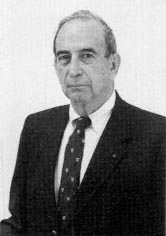
Robert J. Glaser, M.D., who was dean of Stanford's School of Medicine in 1967, wrote the Board on Medicine's heart transplant statement and chaired the Institute's Initial Membership Committee. He also served as acting president of the Institute until John Hogness took office in the spring of 1971. Photograph courtesy of Robert Glaser.
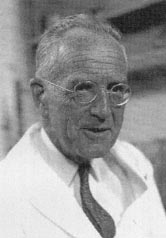
Irvine H. Page, M.D., who was head of the Research Division at the Cleveland Clinic from 1945 to 1967 and a leading expert on hypertension and heart disease, was a strong advocate for the creation of a National Academy of Medicine. He and Walsh McDermott engaged in spirited debates within the Board on Medicine. Photograph courtesy of The Cleveland Clinic Foundation.
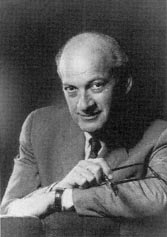
Philip Handler, Ph.D., a well-known biomedical researcher at Duke University who was president of the National Academy of Sciences from 1969 to 1981, played a key role in the creation of the Institute of Medicine and in its early development. His constant goal was to maintain the integrity of the Academy. Photograph courtesy of the National Academy of Sciences Archives.
Presidents of the Institute of Medicine
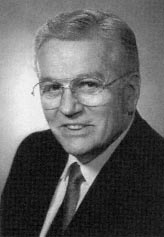
John R. Hogness, M.D. (1970-1974), was the Institute of Medicine's first president. He started the IOM Council and initiated many of the routines that governed the Institute's development.
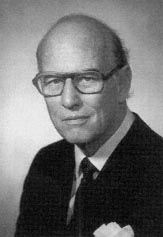
Donald S. Fredrickson, M.D. (1974–1975), a distinguished biomedical researcher, stayed only a short time at the Institute before leaving to become director of the National Institutes of Health.
Presidents of the Institute of Medicine
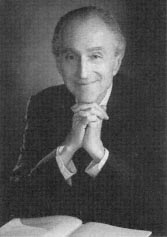
David A. Hamburg, M.D. (1975–1980), helped to bring the Institute to national prominence. He established the divisions that still underlie the basic organizational scheme of IOM.
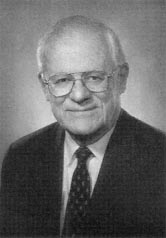
Frederick C. Robbins, M.D. (1980-1985), a Nobel laureate, brought his knowledge of medical research to the Institute, helping the organization to overcome the challenge posed by the Sproull report.
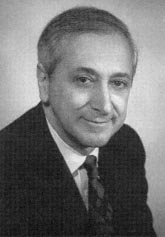
Samuel O. Thier, M.D. (1985–1991), energized the Institute and led a successful fund-raising effort. As a result of his work, IOM reached parity with the other components of the Academy complex.
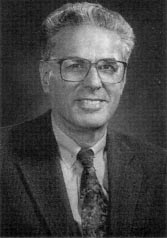
Kenneth I. Shine, M.D. (1992–present), ushered the Institute into its second quarter century. Now in his second term, he is IOM's longest-serving president.
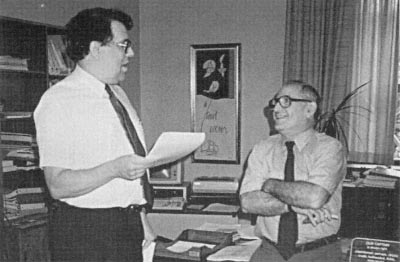
Karl Yordy (left), a durable and valuable member of the Institute's staff, served the IOM from the era of John Hogness into the era of Ken Shine, both as executive officer after Roger Bulger and as director of the Division of Health Care Services. Charles Miller (right) succeeded Yordy as executive officer, serving from 1983 to 1988-years that encompassed threats associated both with possible insolvency and the Sproull report, and then increasing financial security and expansion of the Institute's program. Photograph courtesy of Jana Surdi.
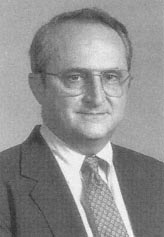
The Institute's first executive officer, Roger J. Bulger, M.D., was a close associate of John Hogness. He guided the daily operations of the Institute in its early years and went on to a distinguished career in medical administration, most recently as president of the Association of Academic Health Centers. Photograph courtesy of the Association of Academic Health Centers.
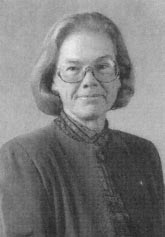
Enriqueta C. Bond, Ph.D. Samuel Thier relied heavily on Queta Bond to manage the day-to-day affairs of the Institute. She served in different capacities under a number of IOM presidents before assuming the presidency of the Burroughs Wellcome Fund in 1994. Photograph courtesy of the Burroughs Well-come Fund.
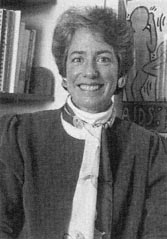
Karen Hein, M.D., a former Robert Wood Johnson Health Policy Fellow, served as the Institute's executive officer from 1995 until 1998 before leaving to become president of the William T. Grant Foundation. Photograph courtesy of Karen Hein.
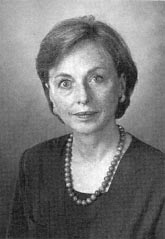
Susanne Stoiber, M.S., M.P.A., was named IOM executive officer in 1998, She came to the Institute from the Department of Health and Human Services, where she was deputy assistant secretary for planning and evaluation. In a previous stint at the Academy, she directed the Division of Social and Economic Studies. Photograph courtesy of Susanne Stoiber.
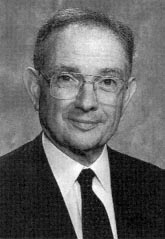
An M.D.-Ph.D. with a background in cardiovascular surgery and long a major figure at the Institute, Theodore Cooper chaired the study that produced Confronting AIDS: Update 1988. Photograph courtesy of Pharmacia & Upjohn.
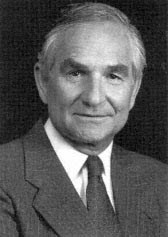
Robert A, Derzon, M.B.A., a distinguished hospital administrator, followed his service as the first head of the Health Care Financing Administration with a period as a scholar in residence at the Institute. He was an IOM Council member during Fred Robbins's tenure and helped recruit Samuel Thier. Photograph courtesy of Robert Derzon.
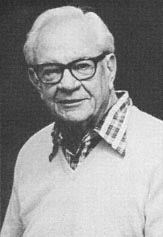
Robert M. Ball, M.A., head of the Social Security Administration from 1962 to 1973, became a scholar in residence at the Institute and served as a confidante of IOM presidents from Hogness through Robbins.

''Watergate''—a national preoccupation from 1972 to 1974, and a word that became synonymous with political scandal— originated with a burglary that took place on the night of June 17, 1972, in this fashionable Washington, D.C., office complex. In 1974, the Institute moved into the 6th-floor offices that the Democratic National Committee had recently vacated. Its offices attracted tourists and others interested in the "stuff of history." Photograph courtesy of Elena Nightingale.
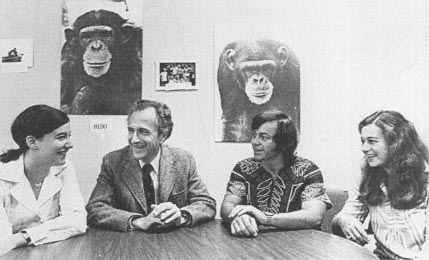
In one of the more unusual circumstances to affect the Institute, before David Hamburg could accept the presidency of IOM in 1975, he needed to negotiate the release of some of his Stanford students who had been kidnapped by rebels in Zaire. He is shown here back in Stanford with (from left) Carrie Hunter, Steven Smith, and Emilie Bergman after their release in the fall of 1975. Photograph courtesy of David Hamburg.
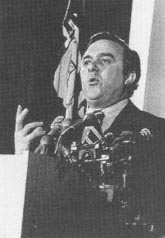
Joseph A. Califano, Jr., LL.B., President Jimmy Carter's Secretary of Health, Education, and Welfare, worked closely with the Institute in the Hamburg era, and ultimately was elected an IOM member and a member of the IOM Council. Photograph courtesy of the History of Medicine Division, National Library of Medicine.

Robert Sproull, Ph.D., a well-known physicist and president of the University of Rochester, chaired a committee whose 1984 report advocated the transformation of the Institute into an academy of medicine and led to some particularly painful moments for the young organization. Photograph courtesy of the University of Rochester.

In early May 1977, a Washington Post article on the recently released IOM study Computed Tomogrophic Scanning caught President Jimmy Carter's eye. The study urged that hospitals and physicians should not overuse the new technology and that local health planners should approve the installation of new scanners, as well as ensure that they operated efficiently. Carter wanted Secretary of Health, Education, and Welfare Califano to read the article as well.

Confronting AIDS (1986) commanded public attention and urged the nation to do more to combat this deadly epidemic. A follow-up report, Confronting AIDS, Update 1988, was used by President George Bush to help formulate government policy toward AIDS.

Preventing Low Birthweight attracted a great deal of attention in part because of the dramatic way in which it was released in the spring of 1985 during hearings conducted by Representative Henry Waxman (D-Calif.).


In recent years, the Institute has produced reports that grab a reader's attention visually as well as engaging them with substantive issues, as the covers of these reports show—Growing Up Tobacco Free: Preventing Nicotine Addiction in Children and Youths (1994, top left), Eat for Life: The Food and Nutrition Board's Guide to Reducing Your Risk of Chronic Disease (1992, top right), and In Her Lifetime: Female Morbidity and Mortality in Sub-Saharan Africa (1996, below). Such covers are strikingly different from the more ultilitarian documents that the Institute produced during its early years.

Current National Academy of Sciences President Bruce Alberts, Ph.D. (left), joins past NAS President Frederick Seitz, Ph.D. (right), at the April 1995 dedication of a portrait of Frank Press, Ph.D. Press, a noted physical scientist from the Massachusetts Institute of Technology, had been President Carter's science advisor prior to taking over as NAS president in 1981. Alberts, a well-known biochemist and molecular biologist from the University of California at San Francisco, succeeded Frank Press in 1993. Photograph courtesy of the National Academy of Sciences.

A letter from President Bill Clinton commemorated the Institute's 25th anniversary in December 1995.













































